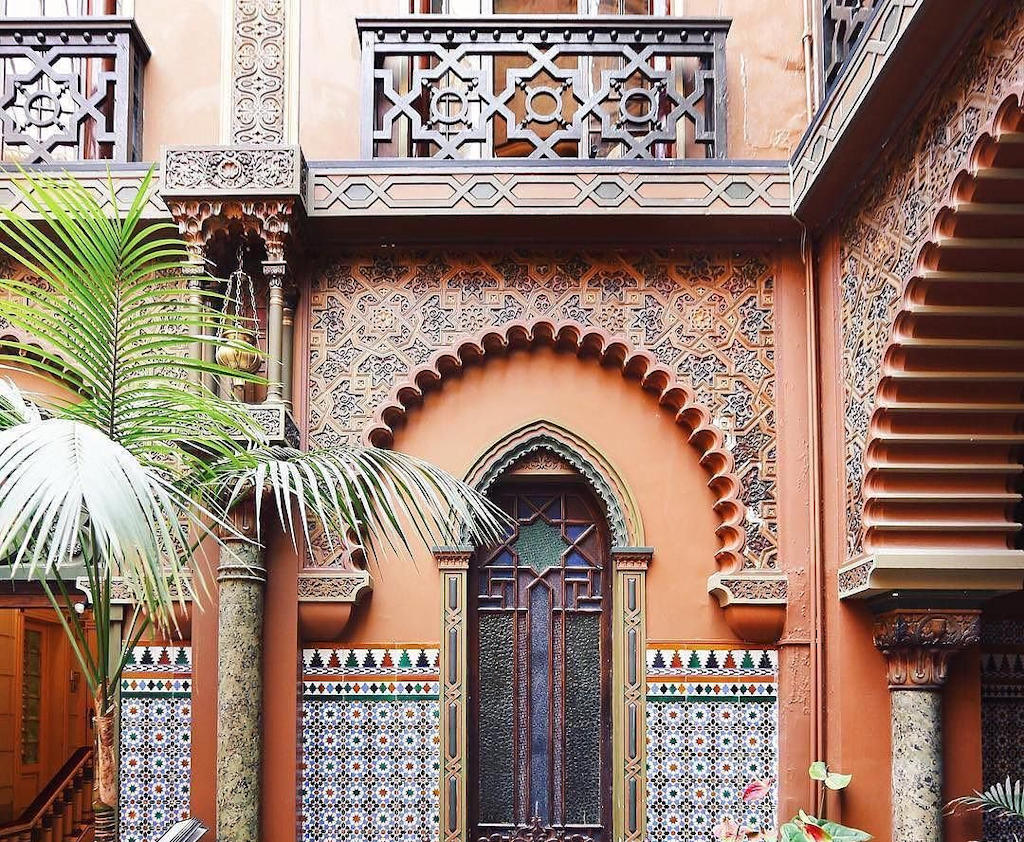Historical Context:
The term "Moorish" refers to the Muslim inhabitants of the medieval Islamic territories in the Iberian Peninsula, known as Al-Andalus. The Moors brought with them a rich artistic and architectural tradition influenced by Islamic art and architecture from North Africa, the Middle East, and beyond. Under their rule, Al-Andalus became a vibrant center of intellectual, cultural, and artistic exchange between Muslims, Christians, and Jews.Key Features of Moorish Art and Architecture:
- Geometric Patterns: Moorish art is characterized by intricate geometric patterns, often consisting of interlocking stars, polygons, and arabesques. These patterns adorn architectural elements, such as domes, arches, and walls, as well as decorative objects like ceramics, textiles, and woodwork. The precision and complexity of these geometric designs reflect mathematical and symbolic significance within Islamic culture.
- Calligraphy: Islamic calligraphy, known as "Kufic" and "Naskh," plays a significant role in Moorish art. Arabic inscriptions from the Quran or poetry are skillfully integrated into architectural elements, tiles, and manuscripts. Calligraphic scripts are seen as a visual expression of the divine word and serve both a decorative and religious purpose.
- Muqarnas: One of the most distinctive features of Moorish architecture is the muqarnas, a type of ornamental vaulting technique. Muqarnas are three-dimensional honeycomb-like structures composed of small pointed niches. They are often found in the ceilings of mosques, palaces, and mausoleums, creating an illusion of weightlessness and adding depth and intricacy to the architecture.
- Courtyards and Gardens: Moorish architecture emphasizes the creation of serene and harmonious spaces. Central courtyards, known as "patios" or "al-fresco," are a common feature in Moorish buildings. These courtyards are often adorned with fountains, reflecting pools, and lush gardens, serving as peaceful retreats and enhancing the sensory experience of the architecture.
Notable Examples of Moorish Art and Architecture in Portugal :
- Alhambra of Silves: Located in the city of Silves in the Algarve region, the Alhambra of Silves is a medieval Moorish castle that showcases elements of Moorish architecture. It was constructed during the 11th century and features imposing walls, towers, and courtyards. The castle's red sandstone walls and architectural details reflect the influence of Islamic design.
- Alcáçova de Mértola: Situated in the town of Mértola in southern Portugal, the Alcáçova de Mértola is a fortress that dates back to the 9th century. Originally built as a defensive structure, it later became a residence for the ruling Islamic governors. The fortress displays a mix of Moorish and Romanesque architectural styles, with its thick walls, narrow alleys, and terraces offering panoramic views of the surrounding area.
- Madrasa of Mértola: Adjacent to the Alcáçova de Mértola, the Madrasa of Mértola is a historic Islamic school that dates back to the 13th century. This beautifully preserved building features decorative arches, stucco work, and inscriptions in Arabic calligraphy. The Madrasa serves as a testament to the intellectual and cultural exchange that occurred during the Islamic rule in the region.
- Lisbon's Alfama Quarter: The Alfama Quarter in Lisbon, the capital city of Portugal, has a significant Moorish influence. As one of the oldest neighborhoods in Lisbon, it contains narrow winding streets, whitewashed houses, and small squares reminiscent of traditional Moorish urban design. The district's layout and architectural elements reflect the historical presence of the Moors in the region.
- Sintra's Castle of the Moors: Situated in the town of Sintra, the Castle of the Moors (Castelo dos Mouros) is a medieval fortress that bears traces of Moorish architecture. Originally constructed during the 8th and 9th centuries, the castle features sturdy stone walls, towers, and a strategic hilltop location. The fortress offers panoramic views of the surrounding landscape and provides glimpses into the region's Moorish past.
Lisbon.vip Recommends
Legacy and Influence:
Moorish art and architecture had a profound and lasting influence on subsequent styles and cultures. Its distinctive features and design principles found their way into Spanish Mudéjar architecture, which fused Islamic, Gothic, and Renaissance elements. Additionally, the Moorish architectural legacy influenced other regions, such as Morocco and the Maghreb, where similar styles and motifs can be found. Moorish art and architecture continue to captivate and inspire visitors, reminding us of the artistic brilliance and cultural exchange that occurred during the Islamic rule in the Iberian Peninsula.Moorish art and architecture represent a fascinating blend of Islamic aesthetics and local traditions, resulting in a unique and captivating style. The interplay of geometric patterns, calligraphy, muqarnas, and serene courtyards creates a visual language that reflects the spiritual and cultural values of the time. As we explore the magnificent structures of the Alhambra, the Great Mosque of Cordoba, or the Giralda, we are transported to a world where beauty, harmony, and cultural exchange thrive. The enduring legacy of Moorish art and architecture reminds us of the richness and diversity of human creativity throughout history.



